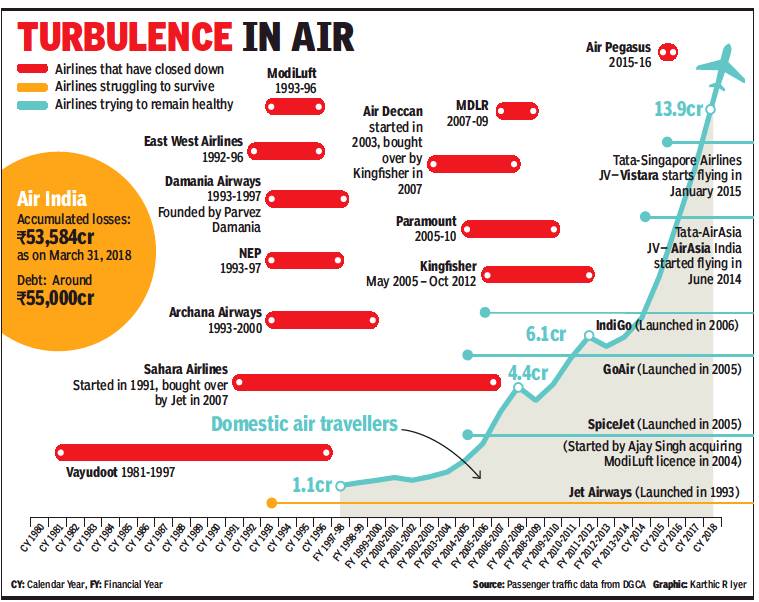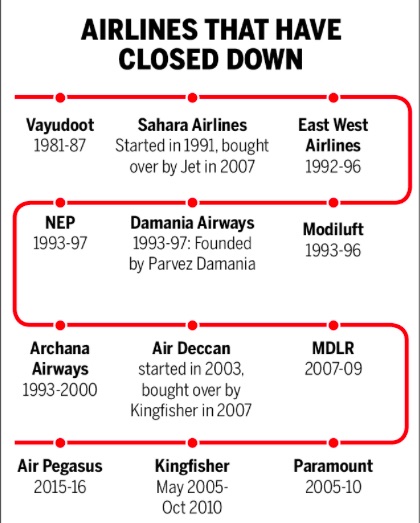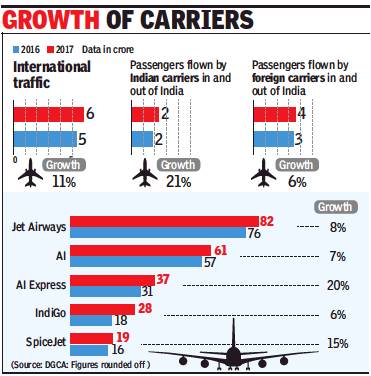Airlines: India
This is a collection of articles archived for the excellence of their content. |
Contents |
Failed airlines
1996-2019: 12 airlines close down
Saurabh Sinha, 12 airlines close down in 21 years, March 27, 2019: The Times of India

From: Saurabh Sinha, 12 airlines close down in 21 years, March 27, 2019: The Times of India

From: Saurabh Sinha, April 13, 2019: The Times of India
Stiff Competition, Below-Cost Fares Take Shine Out Of Steady Rise In Traffic
Naresh Goyal-founded Jet Airways is possibly only the second private airline after SpiceJet to get a shot at reincarnation. The low-cost carrier owes its origin to ModiLuft, which flew from 1993 to 1996. While Indian skies have seen tremendous passenger growth, the country has had its share of airlines that ran out of fuel — 12 in 21 years.
The most prominent failure was Kingfisher. Vijay Mallya, the flamboyant founder of this airline, has sent a series of angry Tweets after Jet minus Goyal was taken over by lender banks. Mallya did manage to get a fair share of Kingfisher debt restructured to equity and banks took a big haircut. He desperately tried in 2011-12 to get the then Congress-led coalition to allow foreign airlines to invest in Indian ones, but failed.
This policy was approved after Kingfisher was shut down in October 2012. That change led to Etihad picking up 24% stake in Jet and Tata Group starting two JV airlines, one each with Singapore Airlines and AirAsia.
“Happy to see that PSU banks have bailed out Jet Airways saving jobs, connectivity and enterprise. Only wish the same was done for Kingfisher…. I invested over (Rs) 4,000 crore into Kingfisher Airlines to save the company and its employees…. The same PSU banks let India’s finest airline with the best employees and connectivity fail ruthlessly… I have placed liquid assets before the Hon’ble Karnataka High Court to pay off the PSU banks and all other creditors. Why do the banks not take my money. It will help them to save Jet Airways if nothing else,” Mallya tweeted from London.
So, what are the reasons behind the grounding of so many airlines despite steady rise in traffic? Indian airlines operate in a cost-hostile environment. Jet fuel for domestic flights is among the priciest here globally, due to steep taxation. A crippling shortage of infrastructure adds to problems as busiest airports like Delhi, Mumbai and Bangalore and even smaller ones have choked terminals and find it hard to accommodate more flights.
Also, intense competition and the race for market share have led to airlines offering below-cost fares, which has led to a situation of profitless growth. “It is not mismanaged Indian airlines, which are being kept alive on ventilator, even the well-run ones have to constantly dodge the bullet,” said an official.
Few airlines in India, including government-owned Air India, have had luck in finding life after near death. Captain Gopinath-founded Air Deccan, India’s first budget airline, was bought over by Kingfisher in 2007 and the latter was shut down in 2012. Air Sahara was bought by Jet in same year as Deccan and now Jet is on the ventilator of lenders.
SpiceJet is an exception. It had its origin in ModiLuft (1993-1996). Less than a decade later, it was bought by Ajay Singh, who launched it as SpiceJet in 2005, along with UK-based NRI Bhulo Kansagra. In 2008, Kansagra sold his stake to US distress investor Wilbur Ross. Two years later, Ross and Ajay Singh sold their stake to Sun Group’s Kalanithi Maran. In 2015, Maran sold his stake back to Ajay Singh.
Jet Airways (2019) vis-à-vis Kingfisher (2012)
Why Jet Airways flies when Kingfisher Airlines couldn't - Mar 27, 2019 |Times of India
Highlights
Months before Kingfisher Airlines stopped flying (in October 2012), the carrier was in a similar situation as Jet Airways today
The factors that led to the mess were similar, as well — high fuel prices, weak rupee and cut-throat competition
Banks were criticised for not seeing signs of trouble at Kingfisher on time
NEW DELHI: Embattled liquor baron Vijay Mallya lashed out at public sector banks for "double standards" for their intervention to bailout Jet Airways while the same lenders made his Kingfisher airlines "fail ruthlessly". Reacting to the take over of management control (and equity) of the troubled Jet Airways by banks led by the State Bank of India, Mallya said, "...only wish the same was done for Kingfisher".
The similarities
Months before Kingfisher Airlines stopped flying (in October 2012), the carrier was in a similar situation as Jet Airways today. It struggled to pay salaries to its 7,000 employees (as Jet has done since September last year), defaulted on payments to lenders (Jet defaulted on its payments in December) and was forced to cancel flights (due to pilot protests compared to unpaid lease in the case of Jet). When Kingfisher was grounded it had an outstanding debt of Rs 7,000 crore (the figure is over Rs 9,000 crore now). Jet owes about Rs 10,000 crore to lenders.
The factors that led to the mess were similar, as well — high fuel prices, weak rupee and cut-throat competition. Plus, like Kingfisher's acquisition of Deccan Airways accelerated its downfall, a major cause of Jet's financial troubles is believed to be the expensive acquisition of Air Sahara in 2006 (which some say was a move to thwart Kingfisher from acquiring it). While keeping Jet airborne is about the market (it controls a sixth of the domestic aviation market) and (16,000) jobs, the same was true for Kingfisher too (in 2007 the airline had almost the same market share as Jet and Jetlite combined). Banks were criticised for not seeing signs of trouble at Kingfisher on time. While the banks seem more proactive this time, Jet has been in the red (its net worth has been negative too) for over five years.
The difference
For one, banks have learnt some lessons after having burnt their fingers with Kingfisher. While they are still looking to salvage the debt extended to Jet by picking up a stake in the company (as they did in Kingfisher’s case), they have realised that it makes sense to sell a running company (even if it means pumping in some more money) instead of letting it go bankrupt.
Two, Reserve Bank of India's strict norms don't give banks much leeway to delay things. The central bank has scrapped all restructuring plans (a big reason for the delay in debt resolutions and recovery) except that driven by the bankruptcy law and empowered banks to treat payments miss, even by a day, as default. Three, there were no elections when Kingfisher went belly up in 2012 (unlike now) and job creation wasn't as big an issue as it is now.
Passenger satisfaction
2019: Vistara best, AI worst

From: July 22, 2019: The Times of India
See graphic:
Passenger satisfaction levels in India’s airlines: 2019
Punctuality
2018-19
Manju V, June 28, 2019: The Times of India
Low-cost carrier IndiGo has emerged as the most punctual airline in India, followed by GoAir and AirAsia India, in the rankings released by UK’s air intelligence group OAG.
IndiGo scored an annual OTP (on-time performance) record of 81% for the 39,295 flights operated between June 2018 and May 2019. The survey assigned star ratings to airlines and airports, ranging from one star to five stars. Airlines and airports with the best on-time performance, for example, the top 10%, received five stars, it said. “IndiGo (81.5%) is the largest low-cost carrier to earn four stars with Jetstar Asia (84.6 %), Thai AirAsia (83.8%) and Solaseed (83.7%) also achieving 4 stars,” said the OAG survey GoAir scored 80% for the 7,058 flights operated in the same period. Both these carriers were given a four star status. AirAsia India with 80% and Vistara with 75% received three stars, while AirIndia with 62% got a one star.
Asian carriers led the rankings with the region being home to 8 of the 13 airlines achieving a 5 star status this year. Within Asia, Japan was the star performer as three out of the top five airlines were Japanese. All Nippon Airways was the region’s largest airline to achieve a five star status.
The top three global airports with best punctuality records were US’s Hilo (94%), followed by Belarus’s Minsk (93%) and Japan’s Nagoya Komaki (92%).
The major Indian airports though didn’t do well in punctuality ratings with Delhi airport (scoring a 76%) and Mumbai (75%), both of whom received a two star status.
Among airports, Nagpur topped the list of most punctual airports with 82% scored for the 22,731flights it handled between June 2018-May 2019.
2017 (international)
See graphics :
International airlines' ranks, market-shares, 2017

International Airlines price and service, as on June 10, 2017


international traffic,
passengers flown by Indian carriers in and out of India,
passengers flown by foreign carriers in and out of India, 2016-17
From: Saurabh Sinha, Indian carriers’ share in int’l traffic up by 2.6%, February 21, 2018: The Times of India
This is one “made by Indians” programme that is showing the desired results.
Last year, 5.9 crore people flew in and out of India — up 11.3% from 5.3 crore in 2016. Indian carriers saw their share in this traffic going up to 38.6%, up a significant 2.6% in just one year from 36% in 2016. The jump came mainly on the back of a solid 58% increase in international passengers flown by IndiGo, followed by soon-to-be-privatised Air India express which saw 20% jump in this traffic.
Since the liberal grant of bilaterals to the Gulf, especially Dubai, by the previous UPA regime had become a controversy, the Modi government has not given more flying rights despite demand from all big players like Emirates, Qatar Airways and Etihad. As a result, the 11% growth in international traffic to and from India seen in 2017 over 2016 is mainly a result of more passengers being carried by Indian airlines.
Five Indian airlines fly abroad — Air India, AI Express, Jet Airways, IndiGo and SpiceJet. In 2016, these five accounted for 1.9 crore of the 5.3 crore passengers who flew in and out of India, which means a share of 36% in overall traffic. In 2017, they accounted for 2.3 crore of the 5.9 crore international traffic which saw their share go up to 38.6% — a jump of 2.6% in just a year.
But where the ‘tortoise’ of Indian carriers of overtook the ‘hare’ of foreign carriers is in these numbers. The five desi airlines saw 21% jump in international passengers in 2017 over 2016 while the growth for foreign carriers was less than a third at 5.9%.
To be sure, a major part of this growth in passenger carriage by Indian carriers is to nearby countries where the single aisle planes of IndiGo (A-320) and AI Express (B-737) fly. The medium and long haul market is dominated by foreign airlines as only AI (up to US and Australia) and Jet (farthest destination being Toronto) fly to the distant places.
“IndiGo has been growing aggressively by adding flights to nearby countries which has seen this mega jump in its international traffic. Had the engine crisis on the Airbus A-320 Neo not slowed down delivery of new planes to IndiGo and GoAir (which does not fly abroad currently), this year would have seen a much bigger jump in share of Indian carriers in overall international traffic to and from the country. GoAir has officially blamed delayed delivery of Neos as the reason for its launch of international flights getting postponed,” said an airline official who did not wish to be quoted.
Combined with the domestic traffic of 11.7 crore, India saw 17.6 crore air travellers last year — up 15.8% from 15.2 crore in 2016.
The growth comes mainly on account of planes flying fuller as major Indian airports like Delhi and Mumbai face a crippling shortage of aviation infrastructure and are unable to handle more flights.
What airlines find hard to believe is the slow rate at which airport capacity is being added in India despite the country being the world’s fastest growing aviation market. A case in point is Delhi which despite having adequate free land has not not built a single new runway or terminal since 2010 when IGI Airport got its third airstrip and terminal 3. Mumbai’s airport has no place to augment infra and now the mega city can get more flights only when the second airport gets ready in Navi Mumbai.
2018, Oct

The market share and aircraft occupancy of airlines in India.
From: November 23, 2018: The Times of India
See graphic:
The number of domestic passengers flown by airlines in India in October 2017 and 2018.
The market share and aircraft occupancy of airlines in India.
2018 vis-à-vis 2017
Saurabh Sinha, AI, arm narrows gap with Jet-Etihad, March 13, 2019: The Times of India

From: Saurabh Sinha, AI, arm narrows gap with Jet-Etihad, March 13, 2019: The Times of India
IndiGo Pips Air India Express To Become Fourth Largest In International Travel
India saw 6.3 crore international travellers last year, up 7.3% from 5.9 crore in 2017. While Jet Airways remained the single-largest airline for flying people in and out of India, its financial troubles coupled with the downsizing of partner Etihad, saw the two airlines together account for 1.06 crore international travellers, down from 1.1 crore in 2017. In fact, the Air India and AI Express together flew almost as many people in and out of India last year as the Jet-Etihad combine, with the latter ahead by just 20,000 passengers. Incidentally, the AIAI Express carried more than 1 crore international passengers for the first time last year.
The year also saw some significant shake-ups in the top-10 list of standalone airlines for international travel. While Jet, AI and Emirates retained the top three in 2018 like 2017, IndiGo pipped AI Express to become the fourth-largest international player in India last year. On the back of adding a-plane-a-week in 2018 and deploying additional capacity on international routes, IndiGo saw its overseas passengers number swell 48% to 41.8 lakh from 28.3 lakh in 2017. AI Express swapped places with IndiGo and became the fifth biggest player.
SpiceJet moved from number 9 in 2017 to 7 in 2018 by overtaking Qatar Airways and Oman Air for international travel to and from India last year. Sri Lankan, which is successfully replicating the Gulf airlines’ model of flying people between India and rest of the world through their hubs, occupied the number 9 slot. Qatar Airways, which was the seventh largest international airline in terms of flying passengers to and from India in 2017, is now at number 10.
GoAir became the sixth Indian carrier to start flying abroad (after AI, AI Express, Jet, IndiGo and SpiceJet) last October. It saw 42,478 international flyers last year. The request of Tata Group JV airlines, Vistara and AirAsia India to start flights abroad is being reviewed by the government.
In 2018, Indian carriers accounted for 40% of the international passengers to and from India, up from 38.6% in 2017.
“The 7.2% growth of international travel could have been much more but was constrained by two factors. One was India not hiking flying rights of airlines like Emirates, Qatar Airways, Singapore Airlines and Turkish. And, second was the slot constraints at Indian airports, especially three metros — Delhi, Mumbai and Bangalore — which makes it very difficult to add flights there. As a result, we have seen a rather subdued growth,” said a senior airline official.
Rank in Asia
2022: IndiGo tops

From: Nov 9, 2023: The Times of India
See graphic:
Annual passengers in 2022
See also
Airlines: India